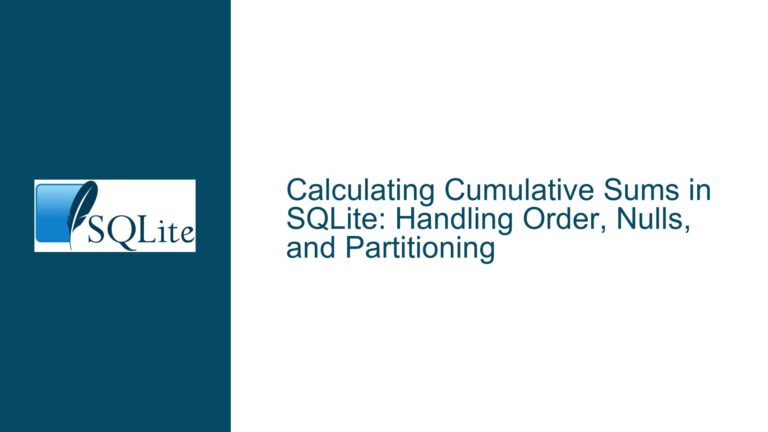Assertion Failure in SQLite RIGHT JOIN with WITHOUT ROWID Tables
Understanding the Assertion Failure in RIGHT JOIN Execution
The core issue revolves around an assertion failure in SQLite when executing a specific query involving a RIGHT JOIN on a view that references a WITHOUT ROWID table. The assertion failure occurs in the SQLite virtual machine (VDBE) during query execution, specifically when the byte-code engine attempts to validate certain cursor operations. The failure is tied to the SQLITE_ENABLE_CURSOR_HINTS compile-time option, which is undocumented and unsupported for public use. This option introduces additional assertions to validate cursor behavior, and the failure arises due to an edge case involving WITHOUT ROWID tables and RIGHT JOIN operations.
The query that triggers the assertion failure is as follows:
CREATE TABLE v1 ( c1 INTEGER PRIMARY KEY ) WITHOUT ROWID;
CREATE VIEW v2 AS SELECT 0 FROM v1 WHERE c1 GLOB 'a' OR c1 == 1;
SELECT 2 FROM v2 RIGHT JOIN v2;
When executed, this query results in the following assertion failure:
sqlite3: sqlite3.c:95129: int sqlite3VdbeExec(Vdbe *): Assertion `pOp[1].opcode==OP_IdxLT || pOp[1].opcode==OP_IdxGT' failed.
The failure is deterministic and can be reproduced consistently under specific conditions, particularly when the SQLITE_QueryFlattener optimization is enabled. Disabling this optimization allows the query to execute without triggering the assertion failure.
Root Causes of the Assertion Failure
The assertion failure is caused by a combination of factors, including the use of WITHOUT ROWID tables, RIGHT JOIN operations, and the SQLITE_ENABLE_CURSOR_HINTS compile-time option. Each of these elements contributes to the issue in distinct ways.
WITHOUT ROWID Tables:
WITHOUT ROWIDtables in SQLite store data directly in the primary key index, eliminating the need for a separate rowid. This design choice optimizes storage and performance for certain workloads but introduces complexities in query execution, particularly when combined with advanced SQL features likeRIGHT JOIN. The absence of a rowid affects how cursors are managed and how indexes are traversed during query execution.RIGHT JOIN Operations:
ARIGHT JOINis a type of outer join that returns all records from the right table and the matched records from the left table. If no match is found, the result set containsNULLvalues for columns from the left table. The implementation ofRIGHT JOINin SQLite involves complex query transformations and optimizations, which can interact unpredictably with other features likeWITHOUT ROWIDtables.SQLITE_ENABLE_CURSOR_HINTS:
TheSQLITE_ENABLE_CURSOR_HINTScompile-time option is an undocumented feature that introduces additional assertions to validate cursor behavior. These assertions ensure that cursors are used correctly during query execution. However, the option is not intended for public use and is only relevant in specialized scenarios, such as when a custom b-tree layer is substituted for SQLite’s built-in implementation. In this case, the assertions fail because the cursor behavior forWITHOUT ROWIDtables in aRIGHT JOINcontext does not meet the expected conditions.Query Optimizations:
TheSQLITE_QueryFlatteneroptimization is designed to simplify nested queries and improve performance. However, in this specific scenario, the optimization interacts poorly with the combination ofWITHOUT ROWIDtables andRIGHT JOINoperations, leading to the assertion failure. Disabling this optimization resolves the issue, but it also sacrifices potential performance benefits.
Diagnosing and Resolving the Assertion Failure
To address the assertion failure, it is necessary to understand the underlying mechanisms and apply appropriate fixes or workarounds. Below are detailed steps for diagnosing and resolving the issue:
Reproduce the Issue:
Begin by reproducing the assertion failure using the provided query:CREATE TABLE v1 ( c1 INTEGER PRIMARY KEY ) WITHOUT ROWID; CREATE VIEW v2 AS SELECT 0 FROM v1 WHERE c1 GLOB 'a' OR c1 == 1; SELECT 2 FROM v2 RIGHT JOIN v2;Ensure that the
SQLITE_ENABLE_CURSOR_HINTSoption is enabled during compilation, as this is a prerequisite for triggering the assertion failure.Analyze the Assertion Failure:
The assertion failure occurs in thesqlite3VdbeExecfunction, specifically when validating the opcode of a cursor operation. The error message indicates that the expected opcode (OP_IdxLTorOP_IdxGT) is not present. This suggests a mismatch between the cursor behavior and the assumptions made by theSQLITE_ENABLE_CURSOR_HINTSoption.Disable SQLITE_QueryFlattener:
As a temporary workaround, disable theSQLITE_QueryFlatteneroptimization using the.testctrlcommand:.testctrl optimizations 0x00000001; .print '-- disable optimization of SQLITE_QueryFlattener' SELECT 2 FROM v2 RIGHT JOIN v2;This prevents the optimization from interacting with the query and avoids the assertion failure. However, this approach is not ideal for production environments, as it may impact query performance.
Recompile SQLite Without SQLITE_ENABLE_CURSOR_HINTS:
Since theSQLITE_ENABLE_CURSOR_HINTSoption is undocumented and unsupported, it is recommended to recompile SQLite without this option. Modify the compilation flags to exclude-DSQLITE_ENABLE_CURSOR_HINTS:export CFLAGS="-g -O0 -DSQLITE_DEBUG -DSQLITE_ENABLE_TREETRACE -DSQLITE_ENABLE_WHERETRACE -DSQLITE_COUNTOFVIEW_OPTIMIZATION -DSQLITE_ENABLE_STAT4"Recompile SQLite and verify that the assertion failure no longer occurs.
Update to the Latest Version of SQLite:
The issue has been fixed in the latest version of SQLite. Update to the most recent release to ensure that the bug is resolved. This is the most robust solution, as it addresses the root cause without requiring workarounds or recompilation.Avoid Unsupported Features:
To prevent similar issues in the future, avoid using undocumented or unsupported features likeSQLITE_ENABLE_CURSOR_HINTSin production environments. Stick to officially supported options and configurations to ensure stability and compatibility.Monitor Query Performance:
After applying the fixes, monitor the performance of queries involvingWITHOUT ROWIDtables andRIGHT JOINoperations. Ensure that the changes do not introduce regressions or performance bottlenecks.
By following these steps, the assertion failure can be effectively diagnosed and resolved, ensuring stable and reliable query execution in SQLite.






